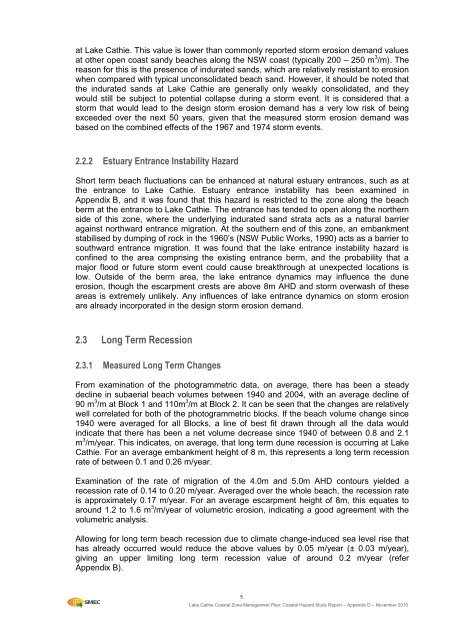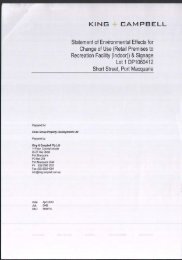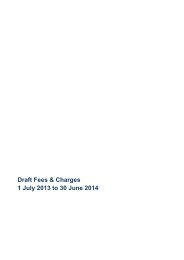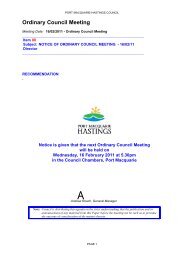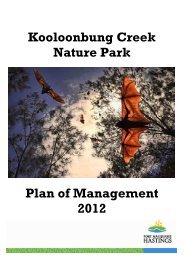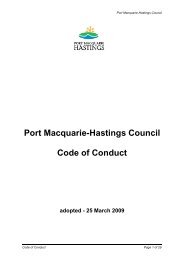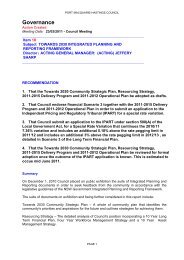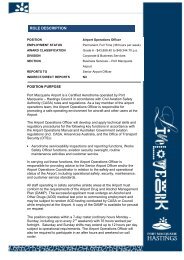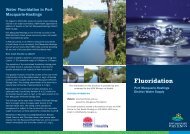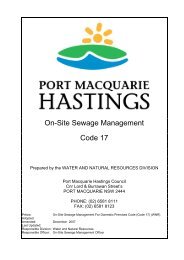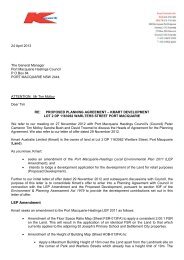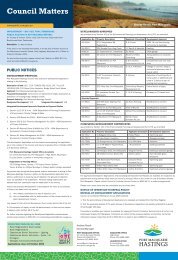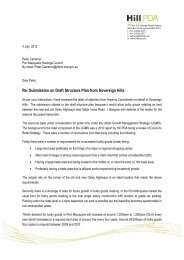Lake Cathie Coastal Hazard Study Appendix D - Hastings Council
Lake Cathie Coastal Hazard Study Appendix D - Hastings Council
Lake Cathie Coastal Hazard Study Appendix D - Hastings Council
Create successful ePaper yourself
Turn your PDF publications into a flip-book with our unique Google optimized e-Paper software.
at <strong>Lake</strong> <strong>Cathie</strong>. This value is lower than commonly reported storm erosion demand values<br />
at other open coast sandy beaches along the NSW coast (typically 200 – 250 m 3 /m). The<br />
reason for this is the presence of indurated sands, which are relatively resistant to erosion<br />
when compared with typical unconsolidated beach sand. However, it should be noted that<br />
the indurated sands at <strong>Lake</strong> <strong>Cathie</strong> are generally only weakly consolidated, and they<br />
would still be subject to potential collapse during a storm event. It is considered that a<br />
storm that would lead to the design storm erosion demand has a very low risk of being<br />
exceeded over the next 50 years, given that the measured storm erosion demand was<br />
based on the combined effects of the 1967 and 1974 storm events.<br />
2.2.2 Estuary Entrance Instability <strong>Hazard</strong><br />
Short term beach fluctuations can be enhanced at natural estuary entrances, such as at<br />
the entrance to <strong>Lake</strong> <strong>Cathie</strong>. Estuary entrance instability has been examined in<br />
<strong>Appendix</strong> B, and it was found that this hazard is restricted to the zone along the beach<br />
berm at the entrance to <strong>Lake</strong> <strong>Cathie</strong>. The entrance has tended to open along the northern<br />
side of this zone, where the underlying indurated sand strata acts as a natural barrier<br />
against northward entrance migration. At the southern end of this zone, an embankment<br />
stabilised by dumping of rock in the 1960’s (NSW Public Works, 1990) acts as a barrier to<br />
southward entrance migration. It was found that the lake entrance instability hazard is<br />
confined to the area comprising the existing entrance berm, and the probability that a<br />
major flood or future storm event could cause breakthrough at unexpected locations is<br />
low. Outside of the berm area, the lake entrance dynamics may influence the dune<br />
erosion, though the escarpment crests are above 8m AHD and storm overwash of these<br />
areas is extremely unlikely. Any influences of lake entrance dynamics on storm erosion<br />
are already incorporated in the design storm erosion demand.<br />
2.3 Long Term Recession<br />
2.3.1 Measured Long Term Changes<br />
From examination of the photogrammetric data, on average, there has been a steady<br />
decline in subaerial beach volumes between 1940 and 2004, with an average decline of<br />
90 m 3 /m at Block 1 and 110m 3 /m at Block 2. It can be seen that the changes are relatively<br />
well correlated for both of the photogrammetric blocks. If the beach volume change since<br />
1940 were averaged for all Blocks, a line of best fit drawn through all the data would<br />
indicate that there has been a net volume decrease since 1940 of between 0.8 and 2.1<br />
m 3 /m/year. This indicates, on average, that long term dune recession is occurring at <strong>Lake</strong><br />
<strong>Cathie</strong>. For an average embankment height of 8 m, this represents a long term recession<br />
rate of between 0.1 and 0.26 m/year.<br />
Examination of the rate of migration of the 4.0m and 5.0m AHD contours yielded a<br />
recession rate of 0.14 to 0.20 m/year. Averaged over the whole beach, the recession rate<br />
is approximately 0.17 m/year. For an average escarpment height of 8m, this equates to<br />
around 1.2 to 1.6 m 3 /m/year of volumetric erosion, indicating a good agreement with the<br />
volumetric analysis.<br />
Allowing for long term beach recession due to climate change-induced sea level rise that<br />
has already occurred would reduce the above values by 0.05 m/year (± 0.03 m/year),<br />
giving an upper limiting long term recession value of around 0.2 m/year (refer<br />
<strong>Appendix</strong> B).<br />
5<br />
<strong>Lake</strong> <strong>Cathie</strong> <strong>Coastal</strong> Zone Management Plan: <strong>Coastal</strong> <strong>Hazard</strong> <strong>Study</strong> Report – <strong>Appendix</strong> D – November 2010


